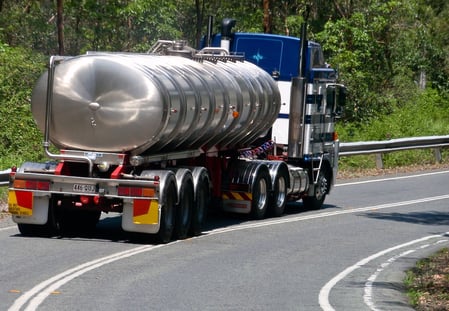 We've been seeing an increase in questions from our shippers regarding tanker endorsements. Specifically what they are and when are they required. So let's dive into the basics on tanker endorsements now!
We've been seeing an increase in questions from our shippers regarding tanker endorsements. Specifically what they are and when are they required. So let's dive into the basics on tanker endorsements now!
What is a tanker endorsement?
Simply put, a tanker endorsement means that drivers with an endorsement are officially licensed and prepared via training to safely haul loads containing significant quantities of liquid. Drivers must have a current CDL and also must pass the Tanker Endorsement Knowledge Test to receive a tanker endorsement. There are a lot of free practice tests online, such as this one, in order to prepare.
When is a tanker endorsement required?
Per the Federal Motor Carrier Safety Administration (FMCSA), a tanker endorsement is required on the CDLs of all drivers who carry liquid loads that total or exceed 1,000 gallons. That 1,000 gallons may be in one tank or distributed across multiple tanks of 119 gallons or more.
You are NOT required to have a tanker endorsement on dry van loads carrying empty tank containers or kegs, for example. It pertains to only liquid freight of large quantities.
Types of tanker endorsements:
There are 2 primary types of tanker endorsements.
- N Endorsement: This endorsement is required of drivers who haul liquids in quantities of over 1,000 gallons.
- X Endorsement: This endorsement is a combination of the regular tanker endorsement with the hazmat endorsement, in order for drivers to haul large quantities of hazardous liquid such as gasoline. An X Endorsement requires the driver to pass the Tanker Endorsement Knowledge Test, pass the hazmat written knowledge exam, and pass a TSA background check.
In order to receive a tanker endorsement, drivers must learn how to handle surge when transporting liquids, how to do a proper pre-trip check for leaks, and how to understand different load requirements. For example, different liquids have different carrying limits because some expand under exposure to heat. Because of this, some liquids aren’t permitted to fill the entire tank while being transported.
Is a tanker endorsement required for dry bulk or for hauling water?
Whether you need a tanker endorsement or not depends entirely on what you are hauling. If you are hauling 1,000 gallons of liquid or more, then the answer is yes. If you are hauling empty containers capable of hauling 1,000 gallons of liquid or more, the answer is no. One involves liquid and the other does not.
As for hauling water, you absolutely need a tanker endorsement if you are hauling large quantities of it. Endorsements are not dependent on the type of liquid being carried - only that it is a liquid. The reason for this is that liquid loads are more dangerous to transport than dry loads because of surge. "Surge" is the term used to refer to the liquid freight that will still be moving back and forth in the tanker even after the truck has come to a full and complete stop. If that surge is strong enough, it is capable of moving the truck even after it has stopped. This is critical to be aware of because surge could push a tanker right into an intersection, if overlooked.
Benefits of having a tanker endorsement:
- Drivers can take on better paying shipments by expanding their load carrying options/capabilities.
- Because of the training required to receive an endorsement, drivers gain additional skills in safely transporting liquids.
- A tanker endorsement can help drivers build up their experience within the industry. Knowing how to safely drive a tanker full of gasoline is not an easy skill to come by and is highly valued.
There is significant knowledge that needs to be acquired in order to move large quantities of liquid - from basic safety experience like knowing how fast one can drive a tanker safely on a curved road, to knowing the distance needed to safely stop a fully loaded moving tanker, to knowing whether or not the liquid being hauled reacts to heat.

